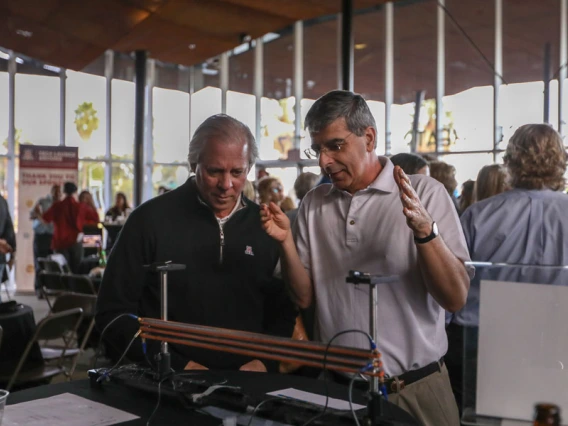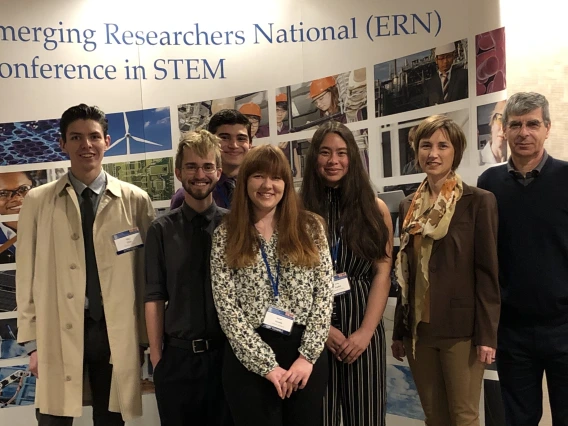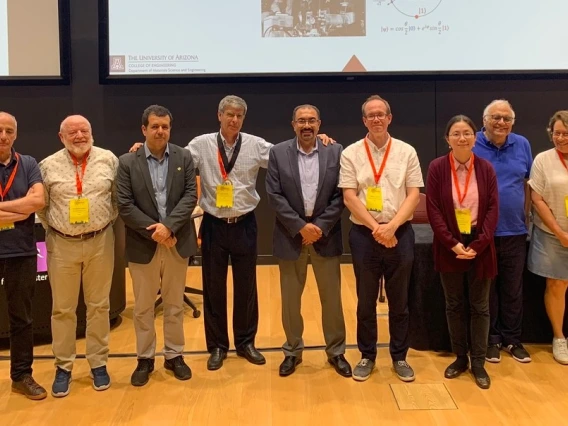UA Scientists Investigate New Frontiers of Sound With $30M Center
The New Frontiers of Sound Science and Technology Center will focus on topological acoustics, an emerging field in which researchers exploit the properties of sound in ways that could vastly improve computing, telecommunications and sensing.

No description provided
The National Science Foundation has granted the University of Arizona $30 million over five years to establish a new NSF Science and Technology Center. The New Frontiers of Sound Science and Technology Center, which comes with an additional $30 million funding option over the following five years, will bring together researchers working in topological acoustics.
With topological acoustics, researchers exploit the properties of sound in ways that could vastly improve computing, telecommunications and sensing. Applications could include reaching quantum-like computing speeds, reducing the power usage of smartphones, and sensing changes in aging infrastructure or the natural environment due to climate change.
"We all know technologies such as the loudspeaker or the microphone, but we also use sound for sensing environments, such as with sonar and ultrasound medical imaging, and for data transmission and processing every day in your smartphone," said center director and project principal investigator Pierre Deymier, a UArizona professor of materials science and engineering in the College of Engineering. "However, the quiet revolution advancing sound science and technology is afoot. And that is where the new center comes in."
Co-principal investigators for the project are Sara Chavarria, assistant dean of research development in the UArizona College of Education and assistant director of the UArizona STEM Learning Center; Chiara Daraio of the California Institute of Technology; Andrea Alù of the Advanced Science Research Center at the City University of New York Graduate Center; and Massimo Ruzzene of the University of Colorado Boulder.
"Scientific discovery is the engine that drives human progress and underlies all of the technologies that we benefit from today," said NSF director Sethuraman Panchanathan. "NSF's Science and Technology Centers enable our most creative scientists and engineers to open new vistas of scientific inquiry and make the discoveries that will keep the U.S. in the forefront of scientific discovery.”
Mapping Sound to Space
Using topological acoustics is a sophisticated way of looking at sound that maps sound waves to an abstract multidimensional space, called a Hilbert Space, to examine their geometry. By examining sound in this way, scientists can see and manipulate attributes of sound waves that aren't visible in traditional acoustics.
"Topological acoustics exploits attributes of sound waves that have remained hidden so far," said Deymier, who has been with the Department of Materials Science and Engineering for more than 38 years and is also a member of the university's BIO5 Institute and a professor in the Applied Mathematics Graduate Interdisciplinary Program. "It harnesses the full power of acoustic waves. That suddenly enables extraordinary properties of sound – such as sound waves that mimic quantum waves or that can hit a hard surface without generating an echo – that can affect a huge number of technologies."
To investigate sound through a topological acoustics lens, scientists form a vector by using all of the points in space that a sound travels through as graph points on the Hilbert Space. The angle of this amplitude vector is known as the geometric phase and provides a visual representation of the geometry of sound.
A simplified example: If a sound is traveling through a room and an object is moved, added or removed, the effect on the sound may not be noticeable when observed through the lens of traditional acoustics, such as frequency. But it could be seen when examined with topological acoustics, because such minor changes alter the geometric phase – that is, they alter the geometry of the sound.
It's essentially supercharging the field of acoustics and allowing researchers to see information they couldn't see before – like putting on a new pair of glasses. Or, better yet, a new pair of hearing aids.
"The remarkable field of topological acoustics could help tackle some of society's biggest challenges, and having our faculty at its forefront will help prepare our students to lead the Fourth Industrial Revolution," said University of Arizona President Robert C. Robbins. "With this center, the University of Arizona is placing itself at the forefront of a growing field and developing a diverse workforce that holds expertise not only in complex research, but in how to apply it to build a better world for all."
An Array of Applications
This improved understanding of acoustic properties could lead to new computing methods, vastly improved telecommunications, and new sensing capabilities for fields such as environmental science and medicine.
- A Quantum Analog – Topological acoustics researchers could take the billions of data points they map from a sound field and use them as input data for computing, creating a system that controls these data points with extremely high precision. Quantum computing exploits unique relationships, such as entanglement, between units of light called photons. But with topological acoustics, researchers could form analogous relationships between units of sound called phonons to reap the same benefits.
- Telecommunications – Devices such as cellphones contain acoustic components that convert electromagnetic waves into acoustic waves and then electrical signals. Because acoustic waves are smaller, they can pass through tiny filtering mechanisms that deliver the correct signal. At higher speeds and capabilities, like 5G and 6G, more filtering mechanisms are required. Engineers and scientists can use topological acoustics to build environments where sound passes through with less energy loss, using less power to increase battery life.
- Sensing – While using sound waves in telecommunications involves preventing the sound waves from scattering as much as possible, sensing uses this scattering to its advantage. The precision of topological acoustics could allow for unparalleled sensitivity in sensing things such as disease in tissue, defects in buildings, dryness of soil in fire-prone forests, and the thawing of permafrost in the arctic.
Educational Element
Those who haven't heard of topological acoustics aren't alone. That is one big reason the center is providing training and education across multiple disciplines and to people from different backgrounds. Establishing a common language for experts in fields ranging from materials science and electrical engineering to geosciences and mathematics will help the world benefit from the work, those involved in the project say.
The researchers will write a textbook and accompanying digital resources about topological acoustics and launch a center-scale Research Experience and Mentorship program to provide opportunities for students underrepresented in STEM to access mentoring and research experience in topological acoustics.
"As a Latina first-generation college graduate, it is important to me that the center emphasizes how committed we are to being inclusive of diverse sciences that align with TA (topological acoustics) work but also inclusive of diverse cultural experiences and backgrounds of our research, education and student community," co-principal investigator Chavarria said. "The outcome we expect is that this field of TA will be one that represents the world's needs, because we will have trained students of diverse backgrounds to be the future TA scientists, engineers, leaders and educators."
"This monumental announcement once again demonstrates Arizona's strong position leading the nation in technological innovation," said Arizona Gov. Katie Hobbs. "We see society's biggest challenges as a chance to innovate, problem solve and forge new horizons, and our public universities like the University of Arizona are a key part of making that happen."
Center partners include CalTech; City University of New York; Georgia Tech; Spelman College; University of Alaska Fairbanks; University of California, Los Angeles; the University of Colorado Boulder; and Wayne State University.
UArizona senior personnel are
- Ivan Djordjevic, professor of electrical and computer engineering and optical sciences
- Joshua Levine, assistant professor of computer science
- Pierre Lucas, professor of materials science and engineering
- Marat Latypov, assistant professor of materials science and engineering
- Krishna Muralidharan, professor of materials science and engineering
- Zafer Mutlu, assistant professor of materials science and engineering
- Hao Zhang, professor and chair of the Statistics and Data Science GIDP and professor of mathematics
- Susan Beck, professor of geosciences
- Tribikram Kundu, professor of civil and architectural engineering and engineering mechanics
- Samy Missoum, professor of aerospace and mechanical engineering
- Minkyu Kim, assistant professor of materials science and engineering and biomedical engineering
- Kasi Kielhbaugh, director of the Health Sciences Design program
- Regina Deil-Amen, associate dean of faculty affairs and professor of higher education in the College of Education
- Corey Knox, associate research scientist in the College of Education





